The external fund manager backed by Berkshire Hathaway's Charlie Munger, Li Lu, makes no bones about it when he says 'The biggest investment risk is not the volatility of prices, but whether you will suffer a permanent loss of capital.' So it seems the smart money knows that debt - which is usually involved in bankruptcies - is a very important factor, when you assess how risky a company is. We can see that Bluestar Adisseo Company (SHSE:600299) does use debt in its business. But the real question is whether this debt is making the company risky.
When Is Debt Dangerous?
Debt assists a business until the business has trouble paying it off, either with new capital or with free cash flow. In the worst case scenario, a company can go bankrupt if it cannot pay its creditors. However, a more common (but still painful) scenario is that it has to raise new equity capital at a low price, thus permanently diluting shareholders. Of course, debt can be an important tool in businesses, particularly capital heavy businesses. The first step when considering a company's debt levels is to consider its cash and debt together.
See our latest analysis for Bluestar Adisseo
How Much Debt Does Bluestar Adisseo Carry?
As you can see below, Bluestar Adisseo had CN¥1.92b of debt at September 2023, down from CN¥2.70b a year prior. However, it also had CN¥958.1m in cash, and so its net debt is CN¥965.4m.

How Healthy Is Bluestar Adisseo's Balance Sheet?
According to the last reported balance sheet, Bluestar Adisseo had liabilities of CN¥3.81b due within 12 months, and liabilities of CN¥2.63b due beyond 12 months. Offsetting these obligations, it had cash of CN¥958.1m as well as receivables valued at CN¥2.02b due within 12 months. So its liabilities outweigh the sum of its cash and (near-term) receivables by CN¥3.46b.
Of course, Bluestar Adisseo has a market capitalization of CN¥22.3b, so these liabilities are probably manageable. However, we do think it is worth keeping an eye on its balance sheet strength, as it may change over time.
In order to size up a company's debt relative to its earnings, we calculate its net debt divided by its earnings before interest, tax, depreciation, and amortization (EBITDA) and its earnings before interest and tax (EBIT) divided by its interest expense (its interest cover). The advantage of this approach is that we take into account both the absolute quantum of debt (with net debt to EBITDA) and the actual interest expenses associated with that debt (with its interest cover ratio).
While Bluestar Adisseo's low debt to EBITDA ratio of 0.68 suggests only modest use of debt, the fact that EBIT only covered the interest expense by 3.5 times last year does give us pause. So we'd recommend keeping a close eye on the impact financing costs are having on the business. Importantly, Bluestar Adisseo's EBIT fell a jaw-dropping 89% in the last twelve months. If that decline continues then paying off debt will be harder than selling foie gras at a vegan convention. When analysing debt levels, the balance sheet is the obvious place to start. But it is future earnings, more than anything, that will determine Bluestar Adisseo's ability to maintain a healthy balance sheet going forward. So if you want to see what the professionals think, you might find this free report on analyst profit forecasts to be interesting.
Finally, a company can only pay off debt with cold hard cash, not accounting profits. So we always check how much of that EBIT is translated into free cash flow. Looking at the most recent three years, Bluestar Adisseo recorded free cash flow of 30% of its EBIT, which is weaker than we'd expect. That's not great, when it comes to paying down debt.
Our View
Bluestar Adisseo's struggle to grow its EBIT had us second guessing its balance sheet strength, but the other data-points we considered were relatively redeeming. In particular, its net debt to EBITDA was re-invigorating. Taking the abovementioned factors together we do think Bluestar Adisseo's debt poses some risks to the business. While that debt can boost returns, we think the company has enough leverage now. The balance sheet is clearly the area to focus on when you are analysing debt. However, not all investment risk resides within the balance sheet - far from it. Case in point: We've spotted 3 warning signs for Bluestar Adisseo you should be aware of.
Of course, if you're the type of investor who prefers buying stocks without the burden of debt, then don't hesitate to discover our exclusive list of net cash growth stocks, today.
Valuation is complex, but we're here to simplify it.
Discover if Bluestar Adisseo might be undervalued or overvalued with our detailed analysis, featuring fair value estimates, potential risks, dividends, insider trades, and its financial condition.
Access Free AnalysisHave feedback on this article? Concerned about the content? Get in touch with us directly. Alternatively, email editorial-team (at) simplywallst.com.
This article by Simply Wall St is general in nature. We provide commentary based on historical data and analyst forecasts only using an unbiased methodology and our articles are not intended to be financial advice. It does not constitute a recommendation to buy or sell any stock, and does not take account of your objectives, or your financial situation. We aim to bring you long-term focused analysis driven by fundamental data. Note that our analysis may not factor in the latest price-sensitive company announcements or qualitative material. Simply Wall St has no position in any stocks mentioned.
About SHSE:600299
Bluestar Adisseo
Engages in the research, development, production, and sale of poultry, ruminant, swine, and aquaculture nutrition additives.
Undervalued with excellent balance sheet.
Similar Companies
Market Insights
Community Narratives



